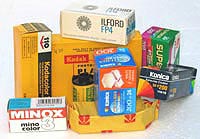
Minox EC
The first model of a Minox was made in Riga, Latvia in 1938. After the WW II the production and the inventor of the first Minox, Walter Zapp moved to Western Germany.
The Minox EC was released in 1981. Until then Minox cameras were highly expensive subminiature cameras which aimed for more or less professional use. Their features included most of the dimensions and equipments demanded by a photographer who don't want to look as a photographer, actually in most cases they are gadgets for a person who has already everything except a high class miniature camera. The EC was Minox's first subminiature camera for an "ordinary" consumer. "A kind of "poor-man's Minox" aimed at users who can't afford a Minox LX" as it is stated on a Submin,com site. An excellent page if you want to know more about this cheap piece of plastic. The price is of course a relative quantity, Compared to the price/pound of Bratz or Barbie dolls it is not a bargain. Anyway it is the smallest and lightest camera Minox produced up until its release and so the price/count is affordable.
Minox EC has a very sharp 4-element 15mm f/5.6 lens (fixed focus at 2 meters), an electronically controlled shutter with speeds from 8 seconds to 1/500 second and fully automatic electronic exposure system. Minox takes 8 x 11mm pictures on a special Minox film. It means that you have to enlarge a picture a lot to get it usable. Perhaps the most annoying limitation in Minox EC is the difficulties in developing the exposed film. If you are not capable or simply don´t want to do it by yourself you have to send a film to a specialist to do that. It takes time and money. So, if you have money only for EC, don't bother, keep it in the showcase.
Perhaps Minox EC should be considered more as a toy or a decoration than a serious camera? Though it has served me as an "Always With" camera. For some years it followed me in a glove compartment of my car. Which by the way is not a good place for a delicate camera at all. Now has Minox displaced by a disposable camera.
Oh Yes, and the size :
W/H/D 80mm closed (96mm extended) /18mm / 30mm .
Weight : 58g with battery and film.
|
Minox 35ML (1986)
Technical data There are cameras, which are blatantly underestimated and there are also cameras which perhaps wouldn't deserve all the eulogies written of them. Minox 35 was introduced at the Photokina in 1974. Minox 35mm cameras have gone through a lot of changes and variations during their life of more than twenty five years, although the main concept has reminded the same. They all are nice cameras and they have many nice features but nothing exceptional compared to other small size 35mm cameras of the same era. Even the most Beautiful Rose has Thorns. The hard to fix back cover fastening clip in my camera has broken and it makes the camera more or less useless. This seems to be a typical weakness in this camera. See, what The Other Martin Taylor. has to say about this camera. (thxMarek) |
|
Packages which are soon displaced by Memory Cards. |
 |

